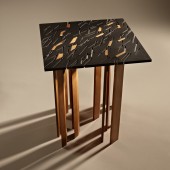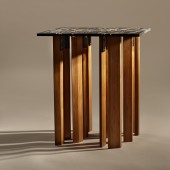TIND End Table End Table by Nils Finne |
Home > Winners > #32764 |
 |
|
||||
| DESIGN DETAILS | |||||
| DESIGN NAME: TIND End Table PRIMARY FUNCTION: End Table INSPIRATION: The formal challenge of the TIND table was to completely integrate the table surface and leg structure, making the two elements inseparable. The bamboo legs pass through the perforated steel top, so that the pattern of the legs is the pattern of the top. UNIQUE PROPERTIES / PROJECT DESCRIPTION: The TIND End Table is a small, eco-friendly table with a strong visual presence. The recycled steel top has been waterjet-cut with an intricate pattern that creates vivid light and shadow patterns. The shapes of the bamboo legs are determined by the patterning in the steel top, and each of the fourteen legs passes through the steel top and then is cut flush. Seen from above, the carbonized bamboo creates an arresting pattern, juxtaposed against the other perforations in the steel. Bamboo is a “rapidly renewable” raw material, since bamboo is a rapidly-growing grass, not a wood product. OPERATION / FLOW / INTERACTION: The table uses sustainable materials to create a user-friendly piece of furniture. The contrast of texture and color between steel and bamboo makes a strong aesthetic and emotional statement. Each material is enhanced by this juxtaposition. PROJECT DURATION AND LOCATION: The design time was about two months and the fabrication time was about two months. Total project duration was four months. The project location was Seattle, Washington, USA. FITS BEST INTO CATEGORY: Furniture Design |
PRODUCTION / REALIZATION TECHNOLOGY: Steel top was waterjet-cut, using direct drive digital files. Bamboo leg shapes were determined by the perforated pattern in the steel top. SPECIFICATIONS / TECHNICAL PROPERTIES: Dimensions: 17” high, 15”x15 overall size Materials: recycled steel, waterjet-cut; carbonized bamboo TAGS: Waterjet-cut steel, bamboo legs, small end table RESEARCH ABSTRACT: The creative goal was to design an end table which completely integrates the table top and the leg structure. This goal was achieved by designing a complex pattern for the perforated steel top, then using that pattern to determine the shape of each leg, made in bamboo. The legs pass through the top and are then cut flush, emphasizing the material contrast between bamboo and steel. CHALLENGE: The most difficult part of the design was designing the structural connection between the steel top and the bamboo legs. ADDED DATE: 2014-02-19 16:29:49 TEAM MEMBERS (1) : IMAGE CREDITS: Photos by Benjamin Benschneider |
||||
| Visit the following page to learn more: http://goo.gl/xqGnCz | |||||
| AWARD DETAILS | |
 |
Tind End Table End Table by Nils Finne is Winner in Furniture Design Category, 2013 - 2014.· Read the interview with designer Nils Finne for design TIND End Table here.· Press Members: Login or Register to request an exclusive interview with Nils Finne. · Click here to register inorder to view the profile and other works by Nils Finne. |
| SOCIAL |
| + Add to Likes / Favorites | Send to My Email | Comment | Testimonials | View Press-Release | Press Kit | Translations |
Did you like Nils Finne's Furniture Design?
You will most likely enjoy other award winning furniture design as well.
Click here to view more Award Winning Furniture Design.








